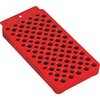PWC
Member
I like to think of myself as a woodworker with lots of tools too. Maybe a "woodworker lite". Last wood blocks I made were for a junior smallbore program and for my SB competition blocks; holes for record shots separate from sighter shots.
Just me, but after completing the round, I drop in the lidded box; saves double handling.
Just me, but after completing the round, I drop in the lidded box; saves double handling.









 Ten minutes too much? Even free hand for a completely utilitarian block...Seriously, it’s not like they wear out.
Ten minutes too much? Even free hand for a completely utilitarian block...Seriously, it’s not like they wear out.



